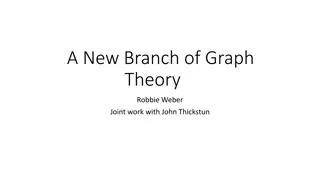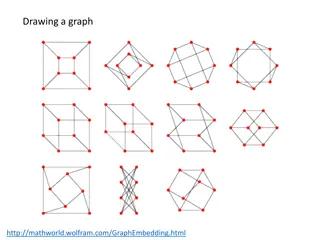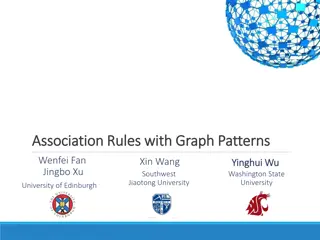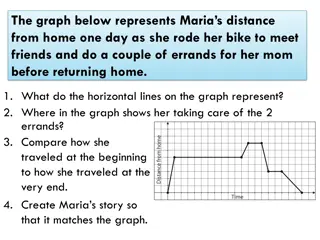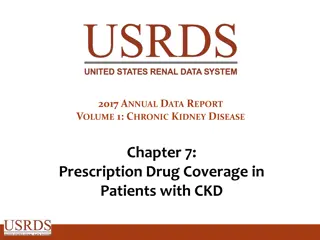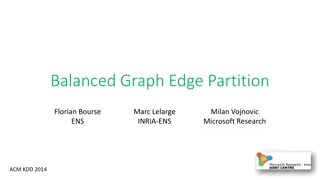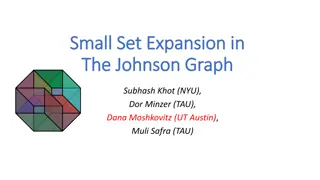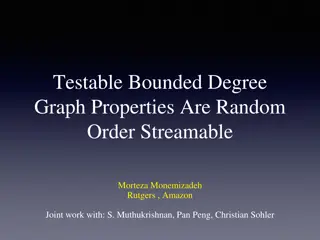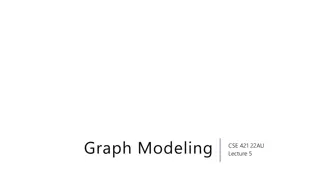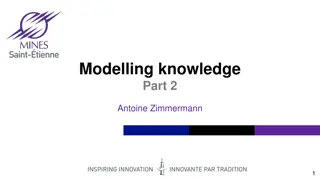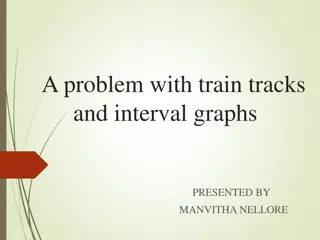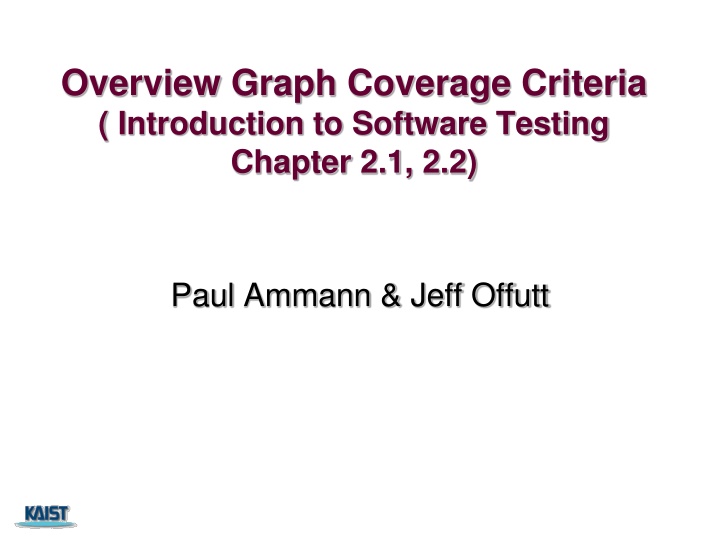
Software Testing Graph Coverage Criteria
Explore the hierarchy of structural graph SW coverages, covering graphs, definition of a graph, paths in graphs, and test paths in software testing. Learn about different types of graphs, nodes, edges, paths, and test cases associated with testing software applications effectively.
Download Presentation

Please find below an Image/Link to download the presentation.
The content on the website is provided AS IS for your information and personal use only. It may not be sold, licensed, or shared on other websites without obtaining consent from the author. If you encounter any issues during the download, it is possible that the publisher has removed the file from their server.
You are allowed to download the files provided on this website for personal or commercial use, subject to the condition that they are used lawfully. All files are the property of their respective owners.
The content on the website is provided AS IS for your information and personal use only. It may not be sold, licensed, or shared on other websites without obtaining consent from the author.
E N D
Presentation Transcript
Overview Graph Coverage Criteria ( Introduction to Software Testing Chapter 2.1, 2.2) Paul Ammann & Jeff Offutt
Hierarchy of Structural/graph SW Coverages Complete Value Coverage CVC (SW) Model checking Complete Path Coverage CPC Concolic testing Prime Path Coverage PPC All-DU-Paths Coverage ADUP Edge-Pair Coverage EPC All-uses Coverage AUC Complete Round Trip Coverage CRTC Edge Coverage EC All-defs Coverage ADC Simple Round Trip Coverage SRTC Node Coverage NC 2/60
Covering Graphs (2.1) Graphs are the most commonly used structure for testing Graphs can come from many sources Control flow graphs Design structure FSMs and statecharts Use cases Tests usually are intended to cover the graph in some way 3
Definition of a Graph A set N of nodes, N is not empty A set N0 of initial nodes, N0 is not empty A set Nf of final nodes, Nf is not empty A set E of edges, each edge from one node to another ( ni , nj ), i is predecessor, j is successor 4
Three Example Graphs 0 1 0 2 0 Not a valid graph 3 4 5 1 2 6 1 2 7 8 3 9 3 N0 = { 0 } Nf = { 3 } N0 = { 0, 1, 2 } Nf = { 7, 8, 9 } N0 = { } Nf = { 3 } 5
Paths in Graphs Path : A sequence of nodes [n1, n2, , nM] Each pair of nodes is an edge Length : The number of edges A single node is a path of length 0 Subpath : A subsequence of nodes in p is a subpath of p Reach (n) : Subgraph that can be reached from n 0 1 2 Reach (0) = { 0, 3, 4, 7, 8, 5, 1, 9 } Paths [ 0, 3, 7 ] Reach ({0, 2}) = G 3 4 5 6 [ 1, 4, 8, 5, 1 ] Reach([2,6]) = {2, 6, 9} [ 2, 6, 9 ] 7 8 9 6
Test Paths and SESEs Test Path : A path that starts at an initial node and ends at a final node Test paths represent execution of test cases Some test paths can be executed by many tests Some test paths cannot be executed by any tests SESE graphs : All test paths start at a single node and end at another node Single-entry, single-exit N0 and Nf have exactly one node Double-diamond graph Four test paths [ 0, 1, 3, 4, 6 ] [ 0, 1, 3, 5, 6 ] [ 0, 2, 3, 4, 6 ] [ 0, 2, 3, 5, 6 ] 1 4 0 3 6 2 5 7
Visiting and Touring Visit : A test path pvisits node n if n is in p A test path pvisits edge e if e is in p Tour : A test path ptours subpath q if q is a subpath of p Path [ 0, 1, 3, 4, 6 ] Visits nodes 0, 1, 3, 4, 6 Visits edges (0, 1), (1, 3), (3, 4), (4, 6) Tours subpaths (0, 1, 3), (1, 3, 4), (3, 4, 6), (0, 1, 3, 4), (1, 3, 4, 6) 8
Tests and Test Paths path (t) : The test path executed by test t path (T) : The set of test paths executed by the set of tests T Each test executes one and only one test path A location in a graph (node or edge) can be reached from another location if there is a sequence of edges from the first location to the second Syntactic reach : A subpath exists in the graph Semantic reach : A test exists that can execute that subpath 9
Tests and Test Paths test 1 many-to-one Test Path test 2 test 3 Deterministic software a test always executes the same test path many-to-many Test Path 1 test 1 test 2 Test Path 2 test 3 Test Path 3 Non-deterministic software a test can execute different test paths 10
Testing and Covering Graphs (2.2) We use graphs in testing as follows : Developing a model of the software as a graph Requiring tests to visit or tour specific sets of nodes, edges or subpaths Test Requirements (TR) : Describe properties of test paths Test Criterion : Rules that define test requirements Satisfaction : Given a set TR of test requirements for a criterion C, a set of tests T satisfies C on a graph if and only if for every test requirement in TR, there is a test path in path(T) that meets the test requirement tr Structural Coverage Criteria : Defined on a graph just in terms of nodes and edges Data Flow Coverage Criteria : Requires a graph to be annotated with references to variables 11
Node and Edge Coverage Edge coverage is slightly stronger than node coverage The length up to 1 allows for graphs with one node and no edges NC and EC are only different when there is an edge and another subpath between a pair of nodes (as in an if- else statement) Node Coverage : TR = { 0, 1, 2 } Test Path = [ 0, 1, 2 ] 0 1 Edge Coverage : TR = { (0,1), (0, 2), (1, 2) } Test Paths = [ 0, 1, 2 ] [ 0, 2 ] 2 12
Paths of Length 1 and 0 A graph with only one node will not have any edges 0 It may be boring, but formally, Edge Coverage needs to require Node Coverage on this graph Otherwise, Edge Coverage will not subsume Node Coverage So we define length up to 1 instead of simply length 1 We have the same issue with graphs that only have one edge for Edge Pair Coverage 0 1 13
Covering Multiple Edges Edge-pair coverage requires pairs of edges, or subpaths of length 2 The length up to 2 is used to include graphs that have less than 2 edges The logical extension is to require all paths Unfortunately, this is impossible if the graph has a loop, so a weak compromise is to make the tester decide which paths: 14
Structural Coverage Example Node Coverage TRNC = { 0, 1, 2, 3, 4, 5, 6 } Test Paths: [ 0, 1, 2, 3, 6 ] [ 0, 1, 2, 4, 5, 4, 6 ] 0 Edge Coverage TREC ={(0,1),(0,2),(1,2), (2,3), (2,4), (3,6), (4,5),(4,6), (5,4)} Test Paths: [ 0, 1, 2, 3, 6 ] [ 0, 2, 4, 5, 4, 6 ] 1 Edge-Pair Coverage 2 TREPC = { [0,1,2], [0,2,3], [0,2,4], [1,2,3], [1,2,4], [2,3,6], [2,4,5], [2,4,6], [4,5,4], [5,4,5], [5,4,6] } Test Paths: [ 0, 1, 2, 3, 6 ] [ 0, 1, 2, 4, 6 ] [ 0, 2, 3, 6 ] [ 0, 2, 4, 5, 4, 5, 4, 6 ] 3 4 5 Complete Path Coverage 6 Test Paths: [ 0, 1, 2, 3, 6 ] [ 0, 1, 2, 4, 6 ] [ 0, 1, 2, 4, 5, 4, 6 ] [ 0, 1, 2, 4, 5, 4, 5, 4, 6 ] [ 0, 1, 2, 4, 5, 4, 5, 4, 5, 4, 6 ] 15
Loops in Graphs If a graph contains a loop, it has an infinite number of paths Thus, CPC is not feasible SPC is not satisfactory because the results are subjective and vary with the tester Attempts to deal with loops: 1980s : Execute each loop, exactly once ([4, 5, 4] in previous example) 1990s : Execute loops 0 times, once, more than once 2000s : Prime paths 16
Simple Paths and Prime Paths Simple Path : A path from node ni to nj is simple, if no node appears more than once, except possibly the first and last nodes are the same No internal loops Includes all other subpaths A loop is a simple path Prime Path : A simple path that does not appear as a proper subpath of any other simple path Simple Paths : [ 0, 1, 3, 0 ], [ 0, 2, 3, 0], [ 1, 3, 0, 1 ], [ 2, 3, 0, 2 ], [ 3, 0, 1, 3 ], [ 3, 0, 2, 3 ], [ 1, 3, 0, 2 ], [ 2, 3, 0, 1 ], [ 0, 1, 3 ], [ 0, 2, 3 ], [ 1, 3, 0 ], [ 2, 3, 0 ], [ 3, 0, 1 ], [3, 0, 2 ], [ 0, 1], [ 0, 2 ], [ 1, 3 ], [ 2, 3 ], [ 3, 0 ], [0], [1], [2], [3] 3 0 1 2 Prime Paths : [ 0, 1, 3, 0 ], [ 0, 2, 3, 0], [ 1, 3, 0, 1 ], [ 2, 3, 0, 2 ], [ 3, 0, 1, 3 ], [ 3, 0, 2, 3 ], [ 1, 3, 0, 2 ], [ 2, 3, 0, 1 ] 17
Prime Path Coverage A simple, elegant and finite criterion that requires loops to be executed as well as skipped Will tour all paths of length 0, 1, That is, it subsumes node, edge, and edge-pair coverage 18
Prime Path Example The previous example has 38 simple paths Only nine prime paths 0 Prime Paths [ 0, 1, 2, 3, 6 ] [ 0, 1, 2, 4, 5 ] [ 0, 1, 2, 4, 6 ] [ 0, 2, 3, 6 ] [ 0, 2, 4, 5] [ 0, 2, 4, 6 ] [ 5, 4, 6 ] [ 4, 5, 4 ] [ 5, 4, 5 ] 1 Execute loop 0 times 2 Execute loop once 3 4 Execute loop more than once 5 6 19
Simple & Prime Path Example ! means path terminates [0, 1, 2] [0, 2, 3] [0, 2, 4] [1, 2, 3] [1, 2, 4] [2, 3, 6] ! [2, 4, 6] ! [2, 4, 5] ! [4, 5, 4] * [5, 4, 6] ! [5, 4, 5] * Simple paths Len 0 [0] [1] [2] [3] [4] [5] [6] ! Len 1 [0, 1] [0, 2] [1, 2] [2, 3] [2, 4] [3, 6] ! [4, 6] ! [4, 5] [5, 4] Len 2 Len 3 [0, 1, 2, 3] [0, 1, 2, 4] * means path cycles [0, 2, 3, 6] ! [0, 2, 4, 6] ! [0, 2, 4, 5] ! [1, 2, 3, 6] ! [1, 2, 4, 5] ! [1, 2, 4, 6] ! 0 1 2 3 4 5 Len 4 [0, 1, 2, 3, 6] ! [0, 1, 2, 4, 6] ! [0, 1, 2, 4, 5] ! 6 Prime Paths Note that paths w/o ! or * cannot be prime paths 20
Weaknesses of the Purely Structural Coverage /* TC1: x= 1, y= 1; TC2: x=-1, y=-1;*/ void foo(int x, int y) { if ( x > 0) x++; else x--; if(y >0) y++; else y--; assert (x * y >= 0); } yes no x>0 x++ x-- y>0 y++ y-- assert(x*y>=0) Purely structural coverage (e.g., branch coverage) alone cannot improve the quality of target software sufficiently -> Advanced semantic testing should be accompanied 21
Final Remarks 1. Why are coverage criteria important for testing? 2. Why is branch coverage popular in industry? 3. Why is prime path coverage not use in practice? 4. Why is it difficult to reach 100% branch coverage of real-world programs? 22






